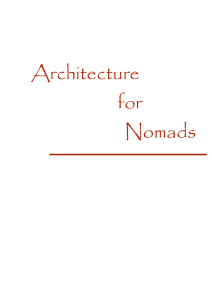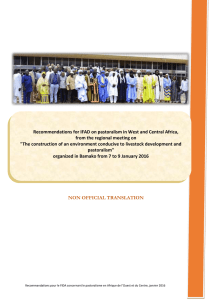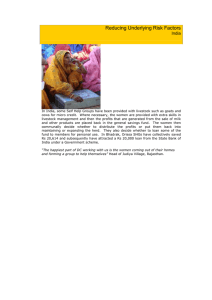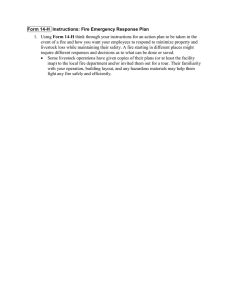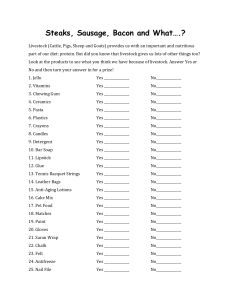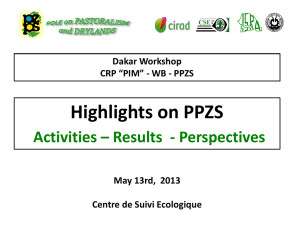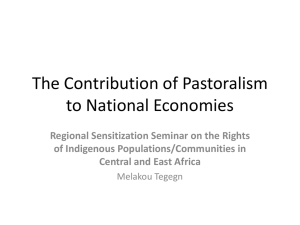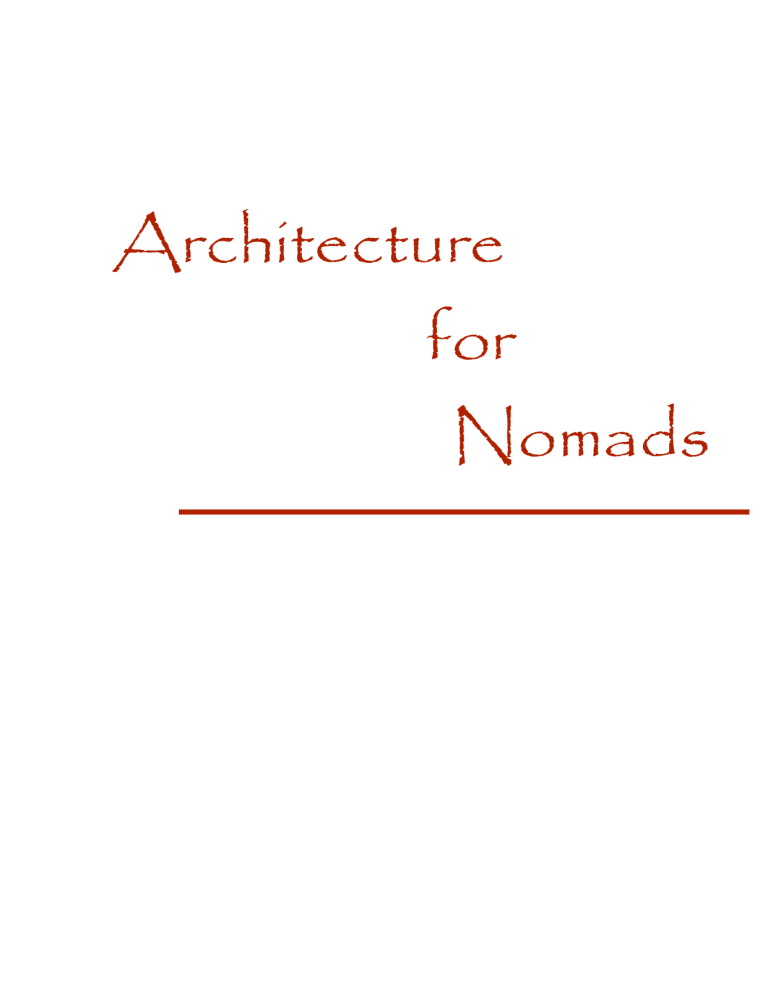
Architecture for Nomads 1. Abstract 2. Pastoralism 2.1 Significance 2.2 Survival mechanisms 3. In Indian context 3.1 Communities 3.2 Timeline of major events 3.3 Adapting to uncertainties 4. Role of Architecture 5. Raikas 5.1 Timeline 5.2 Clans 5.3 Survival mechanisms 5.4 Migrational Patterns 5.5 Camping locations 5.6 Exchanges and Interactions 5.7 Social structure 5.8 Daily life 5.9 Gender roles 5.10 Beliefs, customs, festivals 5.11 Accessible services and facilities 5.12 Restrictions and challenges 5.13 Possibilties and opportunities 6. Laws and policies 6.1 Land use, access, control and management 6.2 Provisions 7. Major movement and mobility networks throughout the state 8. Major Stakeholders and schemes 9. Identifying Site 9.1 Overlap between two entities Abstract The thesis looks at the concept of pastoralism in the current times of modernization. The living habits of pastoralist communities are changing from a nomadic method of life to one of urbanization and is forcing them to adapt to new ways of living. In economics where agriculture and industry are majorly discussed , pastoralism is rarely talked about. The pastoralists whose traditional lifestyles have developed and sustained the ecology of specific regions are now being treated as some figures from the past who have no place in modern society. Their low intensive and suistainable livestock production being significant in current times of climate change and food shortages, demand an urgent need to support and encourage the existing pastoralist systems. The thesis is based in Rajasthan looking at the Raika pastoral community which is well known for rearing camels. Exploring their survival mechanisms leads the thesis further towards a detailed study of their migrational patterns. The emergence of new exclusive infrastructure development, laws and policies is rather making it difficult for the community to survive. Their collapse will have serious implications for both livelihoods and the conservation of biodiversity. Inclusive developmental goals needs to be achieved to support the survival of such indigenous communities and their herds. The thesis intends to explore the possibility of architecture, becoming a part attractor or part program container that allows for the dispensation of basic services to these marginalized nomadic communities and their future generations. Pastoralism is a specialised form of natural resource management adapted to ecosystems and practiced by specific communities. Pastoral resource management relies on the centrality of livestock as the main ‘technology’ for converting available grasslands into human food—animal protein in the form of milk and meat—and other products and also for transferring them from one place to another and from one season to another Survival mechanisms of pastoralists mobility, diversification and exchange Mobility is a factor central to pastoral resource management and livelihood patterns. Mobility is also a strategy for accessing and exchanging products and services, seizing opportunities, or evading animal diseases or other trouble. The geographical dimensions of mobility vary according to conditions and cultures. Why Pastoralism? - Suistainable livestock production - Secure local livelihoods - Remedy for food shortages - Maintain ecological balance of a place - Contributes to the regional economy Indian pastoralism is under-researched and poorly documented. India has the largest livestock population in the world . Pastoral systems in India are quite diverse and contribute significantly to the economy in terms of food security, either directly or by providing services and inputs for agriculture In 2015, extensive livestock-keeping where animals feed on natural grass accounted for roughly 50% of the country’s milk production and met 75 per cent of the national meat consumption. Maldhari, Gujarat Gujjars and Bakarwals, J&K Dhangars, Maharashtra Raika, Rajasthan Timeline 1975 during emergency -central government issued 20 point programme -1 point being protection of forests and establishment of nurseries - they started charging for grazing 1980’s -World bank established a programme to develop Aravallis into National Park 1990 - ban on all livestock from grazing Adapting to uncertainties State interventions aimed at development or modernisation or both, sedentarisation programs, rangeland and wildlife protection, insecurity at the local or regional levels, as well as technological development shortening and re-connecting distances, places, resources and communities all contribute to the reconfiguration of the uncertainties pastoralists experience in the various settings. Role of Architecture Modernization Evolutions of strategies, practices, customs, beliefs and way of living Shifting conditions Emergence of new infrastructure,laws, policies and schemes Risks and constraints Collision between two entities Pastoral Systems - Communities suistainable livestock production, biodiversity conservation Possibilities and opportunities Development Agencies - NHAI Road Amenities, infrastructure Architecture as a medium for bringing two entities together Architecture as an insert to help achieve commom grounds for both entities Analyzing the current risks and constraints and simultaneously looking at possibilties and opportunities through the lens of architecture to support and revive the diminishing pastoral systems and their cultural identities. Keepers of Genes Methodology - Mapping different mobility and movement networks - Different forms of exchanges and interactions - looking at new infrastructure development, laws,policies and relationships and how it affects the community - looking at negotiated contents and the contracts - inclusive infrastructure and amenities along the movement corridors Tracking Mobility and movement The Raikas Raikas are a pastoral community in Rajasthan herding camels, goats and sheep. They are most well known for raising camels Raikas have been preserving and practicing the traditional breeding and ethno-veterinary knowledge for centuries They are located in the western districts of Rajasthan and Gujarat. In the present No entitlement to basic facilities such as education, healthcare,welfare. Less demand for their animal products. Exclusion of the community in policy making and other management systems. Losing their traditional practices of pastoralism and livestock keeping and also their way of living. Younger generation are seeking new livelihoods No government aid NHAI Proposal Camping locations monsoon - Karoli, Sawai Madhopur, It is more the shepherds from Jodhpur, Jalore, Pali and Nagaur districts that are on permanent migration. Dholpur, Kota, Bundi, Jhalawar, and Chittorgarh in Rajasthan. summer - Bulandshahar, Mathura, Agra, Etawah, Etah, Mainpuri, Shikokabad and Hathras winter - Gwalior, Guna, Rajgarh, Ashonagar and Chanderi in Madhya Pradesh. -NHAI is working on the development of wayside amenities based on BOT (Build-Operate-Transfer) -NHAI has identified nearly 183 sites for setting up wayside amenities along National highways Major Road Developments by NHAI - To be located every 40-60 km of the driving distance national highways - Jaisalmer-Barmer - Jodhpur-Pokaran - Karauli-Dholpur - Phalodi-Jaisalmer - Jaipur to Nagaur - 4 laning with PSS of Jodhpur-Pali section - 4 laning of Beawar Pali Pindwara section of NH 14 - 6 Laning of Jaipur-Tonk-Deoli section of NH 12 - 6 Laning of Kishangarh-Ajmer-Beawar section of NH 8 - 4 laning of Ajmer to Nagaur section on NH 89 - 2 laning of Lalsot-Kota section - 2- 6 lanes including rehabilitation of 2 lanes Jaipur-Kishangarh section of NH8 Daily life at camp Wool shearing Process 5 a.m. The dang - The innermost circle is occupied by the women, children and the belongings. - The sheeps are kept in the second circle. - The third circle is occupied by the camels. A site with sufficient water, feed is selected for wool shearing The shepherds rise first and take their sheeps for grazing within 3-5 kms Sheared animals are kept in separate enclosures to avoid confusion while counting 9 a.m. - The men guard the dang in the outer most circle Negotiations are done with the settled farmers for site Sources of Income Raikas earn money by selling milk to tea shops for the use in tea. Raikas also make different products from milk such as cheese, ghee , rice pudding and special tonics Raikas shear the wool of the camel and sheeps very often and it is used for creating a range of items. Wool is filled in sacks The shepherds return and camels are taken out for grazing by other members 12 p.m. Sacks are stored in a dry place on site After lunch the shepherds leave again with the sheeps 1 p.m. Lavas are sent by the wool merchants and prices for shearing are decided upon Animals provide the organic fertilizer for the crops of the farmers on the migration route. Raikas are paid for it with either cash or food supplies. Camels are mostly used for transportation and to carry heavy loads over long distances.Raikas are the main suppliers of camels to farmers and small scale transport entrepreneurs. Once site is finalized wool merchants are contacted Upon completion sacks are transported to the wool mandis Camels return and loaded with household goods to move off to new camping location Shearing happens thereafter References Books and monographs Keepers of Genes (Book) - Ilse Köhler-Rollefson Grass is greener on the other side (Book) - Arun Agrawal How to design with animals(Book) – Edward M. Dodington Indigenous breeds ,Local communities (Book) Indias pastoralists and their breeds by Ilse Köhler-Rollefson : https://www.youtube.com/watch?v=TVvaBQDZmiU https://www.youtube.com/watch?v=sh6AS0xVQjU https://www.youtube.com/watch?v=itFfMd6zP8c Recognising Customary Rights : https://www.youtube.com/watch?v=XCysbFw4cdk Livestock Futures, Ilse Köhler-Rollefson https://www.youtube.com/watch?v=zZ3xmjEWczU
